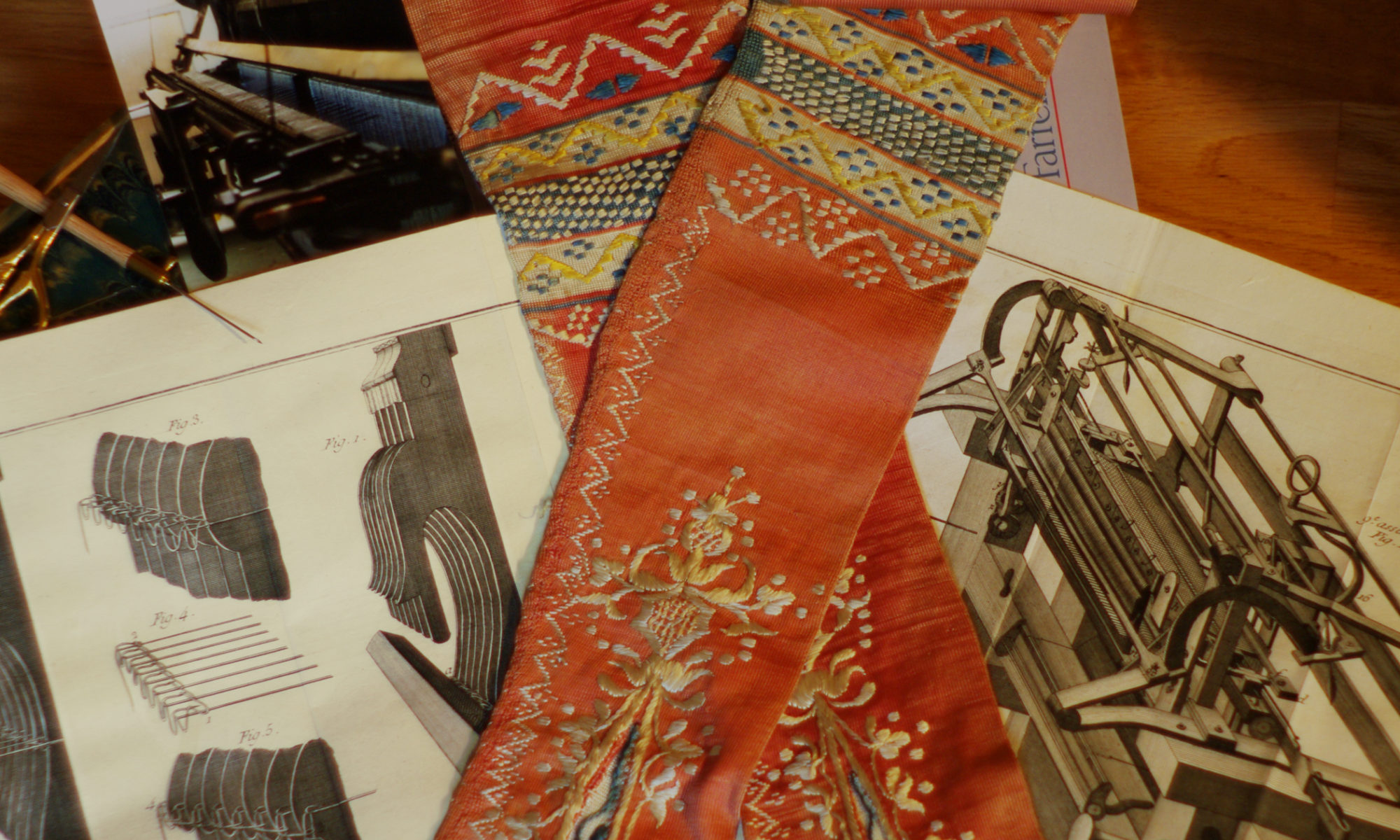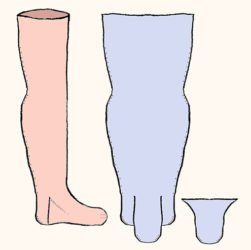Between the difficulty and expense of “perfect” accurate stockings, what are the priorities of choosing what to wear? What do people notice first about stockings, and in what order? With the help of Sue Felshin, Colleen Humphreys, and Sharon Burnston, we came up with an outline for a Hive talk in 2014. This is focused on the American Revolution era, but the ideas can be applied to other time periods or other items.
A. THINGS THAT SHOW
1. Color
a. DIY (dye it yourself). Changing the color of stockings is easy to do with modern dyes, or challenging with natural dyes.
b. Studies have been done of the colors that show up in runaway descriptions, for the prevalence of certain common colors.
c. Light colors will be more noticeable than dark.
d. Black stockings with black shoes will “disappear” from notice.
2. Patterns
a. Is it right for your impression? Designs on stockings changed through the decades.
b. Any pattern will draw the eye more than a plain color. More contrast to the pattern means it is more visible.
i. Clouded: do they look like originals?
– Extant space-dyed stockings are 12 to 25% color.
– Some descriptions are of two different colors of yarn twisted together (before knitting).
– Heathered stockings are two colors of fiber mixed before spinning.
ii. Clocking is decoration, which could be knitted in or embroidered. Most of the 18th century has clocking as a triangular shape at the ankle, same on both sides of the stocking. Some decoration is more subtle, especially in the Rev War years. Do they look like originals? Can they be matched to the decade and outfit portrayed? There are lots of efforts out there, some closer in accuracy than others.
– Position of the clock design on the leg
– Shape of the gore
iii. Stripes
– Some banding (horizontal stripes) can be found, not in visible areas. Many frame knit silk stockings have narrow bands in the top 1/2 inch. Two examples of mid-century ladies’ silk stockings, heavily embroidered, have bands around the knee.
– Vertical stripes are seen. Some apparent depictions of vertical stripes are actually ribs.
iiii. Diced Hose, the checked design worn by highlanders.
3. The seam: Pretty much all stockings had them, either the actual seam of a sewn-up cloth or frame knit, or the ditch created by a purl column on a hand knit.
a. Get or make stockings with a seam.
b. Stitch a tuck on the inside of the stocking for the appearance of a seam.
c. Make a run in the stocking, one stitch wide, and hook it back up to make a purl column. Secure the ends well so it does not fray.
4. Surface texture
a. Ribs, both hand knit and machine knit, are available by the time of the revolution. They tend to be a masculine fashion based on advertisements that specify men’s ribbed stockings, but there is one ad that lists women’s ribbed. The exception that proves the rule?
b. No cables and fancy stitches such as are used on modern highland hose.
c. Lace/openwork patterns are possible to do with both hand and frame knitting. Some stockings had a bit of openwork in the gore, but not yet for the entire stocking. Research carefully vs. your impression.
5. The textile
a. Wool (worsted), silk, linen or hemp (thread), and cotton were used.
b. No elastic or spandex. Wrinkled knees and ankles can be seen in 18thC portraits and sculptures.
i. Synthetics can make a difference in comfort in hot weather
ii. Synthetics can also be a safety issue around fires.
c. A finer knit is a finer/better quality stocking. (Should you be wearing a coarse or fine stocking?)
d. Knits were not as stretchy as our knits today, they were denser. It’s hard to find a fabric with the same density.
i. Modern hand knitters do not knit that tight. It can be done, but sock knitters need to know that the gauge and some construction elements are different for historic stockings.
ii. Modern knitting machines cannot knit that tight without potentially damaging the machine. Some antique bearded needle machines are in use, but are using a looser gauge for light, lacy textiles.
6. Knit to shape
a. Both hand and machine knit stockings of the time rely on decreases and increases to fit the leg. Modern knitting calls it “fully fashioned;” this knit shaping can be seen on either side of the seam.
b. Circular-knit machines were developed in the 1790s, but were coarse and used for hats. Early circular knit stockings (1830s) have a dart in the ankle to shape them to the leg.
c. Stockings cut and sewn from fancy knit yard goods are available in the late 1780s. “Cut ups” from plain knit yard goods are known in the early 19th century.
B. ELEMENT THAT IS PARTIALLY VISIBLE: THE GORE
1. This is part of the heel/foot construction, made with a flap knit down the heel and joined to the foot.
2. The gore can also be a decorative element, made with purl stitches or implied with a shape embroidered later.
3. Check that the gore height fits your portrayal.
4. Some originals have no gore, so nothing appears above the shoe.
C. THINGS THAT ARE NOT VISIBLE (under breeches or inside shoes) The terminology is taken from “Folk Socks” by Nancy Bush, with excellent illustrations of the different elements.
1. Heels
a. “Shaped common heel” is most common, where the heel flap is decreased in the center before binding off.
b. The boxy “common heel” is still around, where the heel flap is folded with no decrease. The common heel is found more in earlier stockings.
c. Band heels are seen on Joseph Gest’s stockings, worn for his 1765 wedding, and are in the Chester County Historical Society. This style of heel is also firmly documented for 1785, with some on the ship, General Carleton of Whitby, made that way.
2. The top/welt/garter is also not stretchy.
a. On some frame knits, the top folded over in construction to form a top hem. Stitching left an open loop inside the hem, and this was a result of the construction and not for any tie or garter.
b. On hand knits and frame knits, some are plain knit and left to roll.
c. On hand knits, garter stitch, alternating knit and purl rows, help keep the top from rolling.
d. On hand knits, ribbing, 1/2″ to 3/4″ of the top, is documented for 1785 (General Carleton) to keep it from rolling, but not stretchy.
3. Toe shapes
a. Hand knit: star
b. Hand knit: wedge
c. Hand knit: 3-part wedge
d. Decrease and bindoff on frame knits
D. WHAT IS OUT THERE IN REPRODUCTIONS
1. Circular knit (tube) with shaped heel.
a. Problem elements include:
i. Stretchier than originals
ii. Short row heel
iii. Stitched toe
b. Improvements that have been made for accuracy:
i. Some have purled seams
ii. Some are re-worked for turned heels.
2. Hand knits
a. Problem elements include
i. Too coarse
ii. Stitch is too loose/stretchy
iii. Modern sock yarn is not like 18thC stocking yarns.
iiii. If modern sock patterns (tops, toes, heels) are used, they are inaccurate.
b. Improvements:
i. Better gauge
ii. Accurate tops, heels & toes
iii. Better yarns

